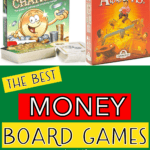Best Money Board Games for Kids and Families
The best money board games make learning about finances easy and fun, turning important skills into engaging activities.
We’ve tried many of these during our family game nights, and some have become favorites.
Whether it’s counting coins, managing allowances, or making strategic investments, these games offer something for kids of all ages.
From simple introductions for younger kids to more complex challenges for teens, these top board games for kids bring a mix of learning and fun to the table.

**This post may contain affiliate links. As an Amazon Associate and a participant in other affiliate programs, I earn a commission on qualifying purchases.**
Best Board Games About Money

Monopoly Junior
We’ve played Monopoly Junior countless times, and it’s become a favorite in our house. It simplifies the traditional Monopoly experience, with fewer rules and smaller numbers, making it easy for younger kids to grasp. My child loves collecting properties and handing out “rent” – without even realizing he’s practicing early math! This version works well as an introduction to concepts like buying, selling, and handling small sums.
Read More
- Players: 2-4
- Age: 5+
- Tip: Use this game to spark conversations about saving for future rounds versus spending immediately.

Money Bags Coin Value Game
This game is a fantastic way to reinforce coin recognition and counting skills. We noticed that after a few rounds, our child was much quicker at identifying coins and adding them up. It turns learning into a race—something our competitive little one really enjoys! Plus, it introduces the idea of exchanging coins, which is a useful skill when learning real-world money management.
Continue Reading
- Players: 2-4
- Age: 7+
- Pro Tip: Let your child act as the “banker” to boost their confidence in handling money.

Cover Your Assets
This card game adds a fun twist with its mix of strategy and luck. We love how it challenges our child to think ahead and protect their “assets.” It’s also a great game for teaching how to handle setbacks since players will inevitably lose some of their hard-earned assets. This game always brings out a lot of laughs (and some friendly rivalries) during family game nights.
Read More
- Players: 2-6
- Age: 7+
- Note: If your family enjoys a bit of competition, this one’s a hit.

Pay Day
This simple yet engaging game does a great job of demonstrating how money flows in and out—just like in real life. My child quickly picked up the idea that earning isn’t enough; it’s about managing what you have. It’s become a go-to for us when we want to mix fun with practical learning. The best part? Pay Day plays quickly, making it perfect for shorter game nights.
Continue Reading
- Players: 2-4
- Age: 8+
- Tip: Use this game to introduce the concept of budgeting in a fun way.

The Game of Life
This game has been a family staple for years. It provides plenty of opportunities to talk about big life decisions—like saving for college, choosing a career, or starting a family. We enjoy discussing the choices along the way and the financial impact they have on the game. It’s a great way to introduce older kids to the idea that life decisions come with financial consequences.
Read More
- Players: 2-4
- Age: 8+
- Suggestion: Play this game together when introducing conversations about long-term goals, like saving or investing.

Exact Change Card Game
This simple but fun game is a favorite in our house. It’s perfect for reinforcing money-counting skills and gives kids plenty of practice making exact change. Matching coins during gameplay has helped my child build confidence with real-world transactions. It’s also fast-paced, which keeps everyone engaged.
Read More
- Players: 2-6
- Age: 6+
- Tip: Use it to spark discussions about making change while grocery shopping or at the store.
- Related: Free coin identification worksheets

What’s in the Bank?
This game stands out with its fun rhyming cards and a mix of strategy and luck. It’s interactive and encourages kids to think quickly, block opponents, or steal their earnings—introducing them to financial competition. While designed with adults in mind, younger kids can enjoy it with guidance, making it a great option for family game nights.
Continue Reading
- Players: 2-6
- Age: 6+
- Note: It’s great for kids who love games with a playful twist, thanks to the fun rhyming mechanics.

Managing My Allowance Money Game
This game offers more than just fun—it teaches kids the difference between wants and needs while helping them manage wages and allowances from real-life tasks. My child loves keeping track of earnings on the included financial record, which makes saving feel like a real achievement.
Read More
- Players: 2-4
- Age: 8+
- Tip: Pair this game with real-life allowance tracking to reinforce the lessons.

Allowance Game
In this light-hearted game, kids try to build savings by creating businesses and managing their spending. We’ve found it’s a great way to teach the value of saving small amounts over time, and the challenge of making change keeps younger players on their toes. It’s simple enough for younger kids but engaging enough to become a regular part of our game nights.
Continue Reading
- Players: 2-4
- Age: 5+
- Pro Tip: Use real coins alongside the game money to reinforce lessons about currency.

Monopoly Ultimate Banking Edition Board Game
Monopoly gets a digital upgrade! With a banking unit and cards instead of cash, this version introduces kids to the basics of credit and debit cards. We found it a great way to spark conversations about digital payments, interest, and financial responsibility. Plus, it keeps things exciting—everyone loves watching their balance change with each move.
Read More
- Players: 2-4
- Age: 8+
- Tip: Use it to discuss the pros and cons of using cards over cash.

Rich Dad CASHFLOW for Kids
Inspired by Rich Dad Poor Dad, this game introduces kids to the principles of cash flow and smart investing. It simplifies financial concepts like passive income, making it easy for young players to grasp. We love how it emphasizes the importance of long-term planning and thinking beyond just earning a paycheck.
Read More
- Players: 2-6
- Age: 6+
- Pro Tip: Pair it with a discussion about budgeting or allowances for added value.

Big Money Family Board Game
This game has become a hit at our house! With options to invest in candy factories or high-tech labs, kids quickly get the hang of how investments can grow (or shrink). It’s lighthearted, fast-paced, and filled with opportunities to talk about financial risk-taking in a playful way.
Read More
- Players: 2-5
- Age: 8+
- Note: Perfect for kids who enjoy strategy mixed with a little silliness.

The Entrepreneur Game
This game is a fantastic way for older kids to explore what it takes to start and manage a business. From handling loans to managing marketing expenses, it challenges players to think like business owners. We’ve enjoyed how it encourages conversations about entrepreneurship and the realities of running a business.
Read More
- Players: 2-6
- Age: 12+
- Tip: Use this game as a springboard for discussing real-world business ideas.
- Related: Financial literacy books for middle school

Exchange
This game simulates the ups and downs of trading, encouraging strategic thinking and quick decision-making. We’ve had fun seeing who could corner the market during family game night! It’s great for introducing concepts like supply and demand in an approachable way.
Read More
- Players: 3-6
- Age: 10+
- Pro Tip: Follow up with a conversation about current stock trends to connect the game with real-world finance.

Rich Dad CASHFLOW
This version of CASHFLOW is ideal for teens ready to take their financial knowledge to the next level. It covers concepts like escaping the "rat race" and building passive income streams. It’s a bit more complex but offers a rewarding experience for older players.
Read More
- Players: 2-4
- Age: 14+
- Note: This game pairs well with lessons on personal finance and investment strategies.

Bulls and Bears – Strategy Board Game
Bulls and Bears teaches financial planning through saving, spending, and investing. It’s a great tool for introducing kids to stock market concepts and the difference between bullish and bearish market strategies. We’ve found it helpful for starting conversations about financial trends.
Read More
- Players: 2-6
- Age: 14+
- Pro Tip: Use this game as an opportunity to explain financial news and market trends in simple terms.

Cash ‘N Guns Party Game
This game brings out the inner gangster (in a playful way) with foam pistols and competitive strategies. While it’s lighthearted, it’s important to emphasize that it’s purely for fun. We’ve found that older kids enjoy the humor and strategy, but we wait until about age 12 to play, so everyone understands the difference between the game and reality.
Read More
- Players: 4-8
- Age: 10+ (Recommended 12+)
- Note: A fun way to introduce negotiation skills, but play with care.

Stock Exchange Game
With three levels of play, this game is adaptable for families and more advanced players. It’s based on real stock market principles, making it a fantastic learning tool for kids interested in finance. We like how it allows for different strategies, from conservative to aggressive investing.
Read More
- Players: 2-6
- Age: 10+
- Pro Tip: Use it as a starting point for talking about how investments grow over time.
Last Updated on 8 April 2025 by Clare Brown



